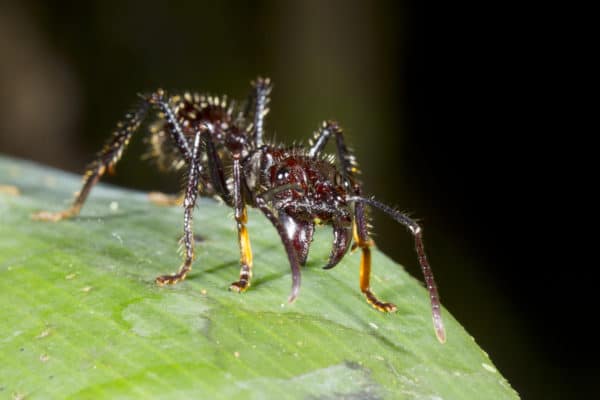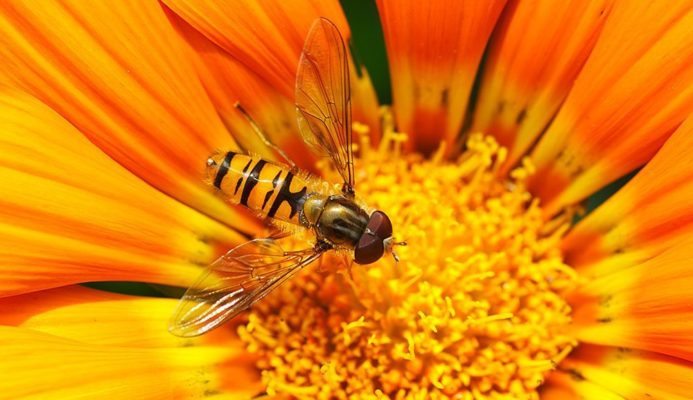
Sacrificing for Science
Entomology is the study of insects, and Modern Pest employs several highly-skilled entomologists. They train and advise our Service Professionals so they can be experts in the field. Entomologists study insect environments and behaviors, and entomologist Justin Schmidt has become an expert on one particular insect behavior: stinging.
Schmidt works at the Carl Hayden Bee Research Center in Arizona and has published several papers about the stings of hymenopteran (an insect group that includes wasps, bees, and ants). He also claims to have been stung by most them.
Are you having an issue with sting insects at your home or business? Call Modern Pest today at 1-800-323-7378 to schedule service!
The Schmidt Pain Level Index
In 1983, he created the Schmidt Sting Pain Index, a scale that rates the relative pain caused by different hymenopteran stings. He categorized the stings by rating them from one to four.
- Level 4: bullet ant, tarantula hawk wasp
- Level 3: paper wasp, harvester ant
- Level 2: honey bee, yellowjacket wasp, bald-faced hornet
- Level 1: fire ant, sweat bee
Schmidt started thinking about his scale while working as a chemical ecologist and studying interactions between insects and their environments. His fieldwork involved collecting different species, which also meant plenty of chances to get stung. He was fascinated by the defense mechanisms of wasps, bees, and ants.
“It occurred to me that while the venom could be analyzed, it was harder to make comparisons between the type of pain each insect caused, which seemed crucial in understanding how and why different types of sting had evolved,” Schmidt said.
Describing the Sting
Schmidt took it upon himself to rank the pain caused by different insects. The most aggressive insects with the most powerful stings tend to live in areas with the highest number of fierce predators. To test this, Schmidt would rate the pain and write a description whenever he was stung. Over the last 35 years, Schmidt has been stung by 150 species of insects. He still updates his pain index when he’s stung by a new insect. The study was recently published in full for the first time.
Level 1 includes fire ants and sweat bees. Schmidt describes a fire ant sting as, “Sharp, sudden, mildly alarming. Like walking across a shag carpet and reaching for the light switch.”
He calls the Level 1 sting of the sweat bee, “light, ephemeral, almost fruity. A tiny spark has singed a single hair on your arm.”
Far different from these mild stings are the Level 4 attacks of the bullet ant, tarantula hawk, and warrior wasp. Schmidt considers these the worst.
“Level 4 you don’t want to know,” Schmidt said.
He describes the sting of the warrior wasp as, “Torture. You are chained in the flow of an active volcano. Why did I start this list?” A warrior wasp sting brings two hours of agony. Equally terrible is the Level 4 sting of the tarantula hawk: “Blinding, fierce, shockingly electric. A running hair dryer has just been dropped into your bubble bath.”
The ultimate in pain on Schmidt’s index is the Level 4-plus bullet ant. Schmidt calls them the “queens of sting” (only females can sting) and first encountered one in Brazil. They’re called bullet ants because their sting is supposed to be akin to getting shot. Their venom contains poneratoxin, a paralyzing neurotoxic peptide. And while it doesn’t do any long-term damage, it does produce 24 hours of agony. Schmidt described it as, “Pure, intense, brilliant pain…like walking over flaming charcoal with a three-inch nail embedded in your heel.”
Local Stingers
New England residents are no strangers to insect stings, either. Yellowjacket wasps and other stinging insects in New England are most concerning to humans from August through October. By then, a colony can contain thousands of wasps that will aggressively defend their nest from intruders. Their large populations also scavenge for human food at barbecues, campsites, fairs, and other outdoor activities this time of year. Yellowjackets are easily provoked and can sting multiple times. They are responsible for 70% of stings in North America and will even chase their target for large distances. Even the vibration from a lawnmower in a yard can incite them to attack.

Despite their extreme aggression, Schmidt only ranks the pain of a yellowjacket sting at Level 2. He described it as, “Hot and smoky, almost irreverent. Imagine W.C. Fields extinguishing a cigar on your tongue.”
Other local stinging insects that rank a Level 2 on the pain index include honey bees, European hornets, and bald-faced hornets. Schmidt describes their pain as:
- Honeybee: Like a matchhead that flips off and burns your skin.
- European hornet: Like a matchhead that flips off and burns your skin.
- Bald-faced hornet: Rich, hearty, slightly crunchy. Similar to getting your hand mashed in a revolving door.
The most painful sting you could receive in the New England-area is that of a paper wasp. Schmidt ranks it a Level 3 on the pain index and describes it as: “Caustic and burning. Distinctly bitter aftertaste. Like spilling a beaker of hydrochloric acid on a paper cut.” Considering how bad that sounds, it’s almost impossible to fathom a pain level 4 sting.
Don’t let your family or guests get stung at your house! Call Modern Pest today for a free quote or to schedule service 1-800-323-7378
The Modern Solution
Justin Schmidt’s experiments with insect stings are interesting to read about, and his pain descriptions are certainly funny. But it’s not an experience you want to have in your home. Modern Pest’s Homecare Green program protects against 60 common household pests, including carpenter ants, mice, pantry pests, flies, and of course, stinging insects. So, leave the pain index to the pros, and stay safe inside your home with Modern Pest. Call Modern today at 1-800-323-7378 for a free quote or to schedule service.
